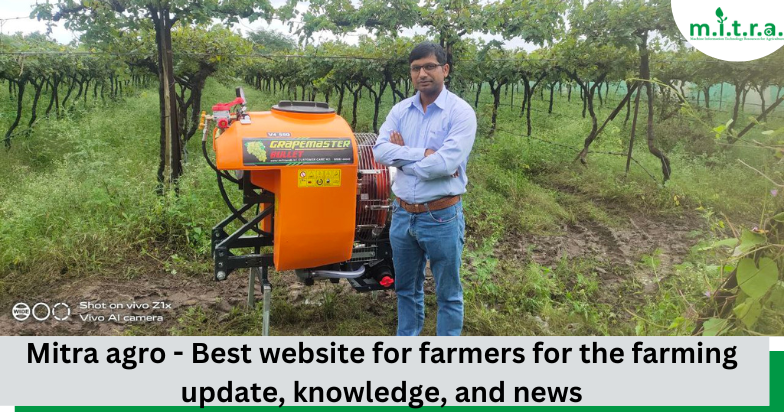Agriculture World
Over 60% of Indians rely on our farmers for food, farming, and economic stability. In addition to providing farmers with access to high-quality seeds, the proposed Seed Bill facilitates “ease-of-doing-business” in the seed industry, according to the National Seed Association of India. India must strengthen its foothold in the international marketplace to reach our target of a $5 trillion economy.
In today’s increasingly globalized economy, Indian farms no longer provide food for the country, the state, or even the rest of the globe. Global concerns have once again brought attention to this situation. It’s solidified India’s position as a world leader in agricultural production. The most efficient spray method is to get a small tractor sprayer equipped with a PTO blower.
Facilitation of agricultural research
There are more demands on India’s agricultural sector, yet most of its challenges remain the same. Agricultural difficulties in India persist due to a variety of factors, including, but not limited to, climate change, soil erosion, pests, and lack of suitable seed varieties, inadequate water supplies, and inadequate irrigation. But modern technology and discoveries, as well as the application of scientific thought to farming, are ushering in a revolution that may be the most significant in Indian agriculture since the Green Revolution.
Research and development were conducted on an air assisted sprayer with five-port nozzles to increase spray penetration into the thick nursery canopy.
Until recently, Indian farmers were at the mercy of the elements. However, new digital technologies such as ICT, IoT, Big Data, cloud, blockchain, etc., along with meteorological sciences and satellite farming developments, are making agriculture more predictive and adaptable to uncertainties. Soil quality and moisture content are two examples of agricultural parameters increasingly being evaluated with satellite technology. Farmers now have access to up-to-date information on weather patterns, rainfall trends, etc., and these forecasts are considerably more accurate than in the past.
Supporting Integrity
The highly dispersed agricultural landscape of the country is gradually coming together thanks to technological advancements. Between 90 and 150 million Indians make a living off the land (93.09 million households). Ninety percent of these people rely on their marginal and tiny (between 0 and 2 ha) to medium-sized landholdings (2-10 hectares). When one considers that the typical size of a working holding is only 1.08 ha, the degree of fragmentation becomes clear.
It paves the way for distributing goods and services to the agricultural sector and disseminating cutting-edge scientific findings. What’s more, it fosters openness and confidence among farmers. When combined with water (or oil) and phytosanitary chemicals, the agricultural mist blower is the equipment used to spray crops. Having direct access to larger markets, with the guarantee of complete pricing and a greater return on investment, is a boon for farmers. Through digitalization, Indian agricultural products and practices are becoming more traceable, increasing consumer and market confidence.
Mechanization Now Possible
As practiced in the West, farm automation and corporate farming have failed miserably in India. It is because small landholders in India cannot afford to buy or lease expensive machinery, unlike their counterparts in more industrialized and less populated countries.
Drones have improved the accuracy of field mapping, drainage pattern determination, data, intelligence collection, crop monitoring, surveillance, spraying from agriculture sprayer machines, and seed planting. Improved resource utilization and higher energy efficiency by incorporating drones into Indian farming contribute to lower costs and higher productivity.
Utilizing All Available Means
Agriculture requires an abundance of energy and water. Water use in agriculture has increased due to the demand for greater yield and longer production cycles. The groundwater level is dropping as a direct consequence of this trend towards more water waste. Drip irrigation and other forms of micro-irrigation are now widely used in agriculture and are among the most important technological advances in this field. Drip and sprinkler irrigation systems now account for more than 19% of irrigated land. The agricultural sector uses about 20% of India’s total energy consumption. The use of solar energy to power agricultural machinery is increasing, including pumps, feeders, and other tools.
Inspiring a new breed of agricultural entrepreneurs
One of the most significant advantages of technological and innovative farming is encouraging a return to agriculture by younger generations. As younger people have gone to metropolitan regions searching for professional jobs, the agricultural industry has experienced a labor shortfall in recent decades.
Reviving enthusiasm for the industry is now due to Mitra. Educated professionals, including those from IITs and those trained at overseas colleges, are launching start-ups to build technology to achieve these goals to make agriculture a more valuable, appealing, sustainable, and knowledge-intensive business. Next-generation farmers are becoming increasingly interested in farming. The amount is sufficient to sufficiently cover the cost of acquiring conventional target-sensing equipment for an Orchard sprayer.
India needs to invest its human resource and knowledge in the agricultural value chain to become the world’s food bowl. Indeed, Mitra is reshaping Indian agriculture for the 21st century.
Mitra provides Variety of Sprayers
Which Sprayer Suits Your Needs?

